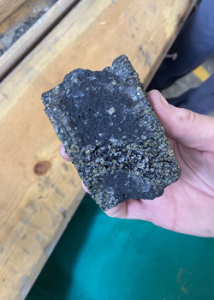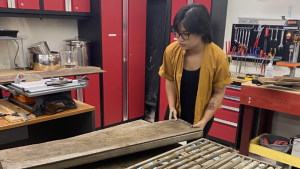
Earth scientists from the University of Hawaiʻi at Mānoa were gifted a set of precious basalt samples collected by the U.S. Geological Survey (USGS) from the Kīlauea Iki lava lake between 1959 and 1988. Investigating these samples will provide new insights for understanding recent and future volcanic eruptions in Hawaiʻi.
“This set of lava core samples is one-of-a-kind. This type of multiple decade-long sampling of a magma body will unlikely be ever done again in Hawaiʻi or elsewhere,” said Tom Shea, earth sciences assistant professor in the UH Mānoa School of Ocean and Earth Science and Technology (SOEST).

In 1959, a large eruption filled an existing crater at the summit of Kīlauea with a lava lake. Over the next three decades, USGS drilled into this area to collect cores of cooling lava, noting the date, location and temperature of the rocks.
“This set of lava cores represents a remarkable, 30-year-long magma cooling experiment that enables us to track chemical changes in olivine through time, to see if they behave like faithful ‘crystal clocks’,” said Shea.
From thin sections to lava cores
Previously, Shea and his team had analyzed thin slices of these samples, shared by USGS collaborator Rosalind Helz. Olivine, the light green mineral common in basalt, acts as a type of crystal clock. It records progressive smearing of the boundaries between different elemental compositions, a change that occurred over the decades of cooling of the lava lake. Volcanologists typically use the distribution of chemical elements, from core to rim, to infer time since the eruption.
Nabila Nizam, a doctoral candidate in the SOEST Department of Earth Sciences, works with Shea on crystal clocks as part of a National Science Foundation-funded CAREER project, investigating how distinct chemical zoning in olivine grains gets progressively smeared with time. In the course of her work on the thin sections, she and Shea discovered that the Hawaiian Volcanoes National Park wanted to find a new home for some Kīlauea Iki drill cores. USGS collaborator Frank Trusdell worked hard with them on a drill core rescue mission.

“We set out on several trips to the National Park to characterize what was there, and clean and select some subsamples,” said Nizam. “Every box we opened was like viewing another surprise! Eventually, we shipped two full drill core sets (16 core boxes for each set) by boat to Honolulu earlier this year.”
These boxes of drill cores will be housed at SOEST and will be a part of research projects and available for appreciation.
“It’s thrilling to host this treasure trove of samples,” added Shea. “They have beautiful olivine crystals that will provide unmatched constraints on the rate at which different elements move within a mineral with time.”
The cores will allow the researchers to ground the theoretical cooling model that Earth scientists have been working with. With these samples, they know the exact timing and the temperature the lava lake was when the samples were collected.
–By Marcie Grabowksi

